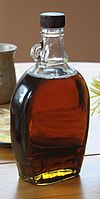
Photo from wikipedia
Sugar maple (Acer saccharum) forests are among the main forest types of eastern North America. Sugar maple stands growing on Appalachian soils of the Lower St-Lawrence region are located at… Click to show full abstract
Sugar maple (Acer saccharum) forests are among the main forest types of eastern North America. Sugar maple stands growing on Appalachian soils of the Lower St-Lawrence region are located at the northeastern limit of the northern hardwood forest zone. Given the biogeographical position of these forests at the edge of the boreal biome, we aimed to reconstruct the fire history and document the occurrence of temperate and boreal trees in sugar maple sites during the Holocene based on soil macrocharcoal analysis. Despite having experienced a different number of fire events, the fire history of the maple sites was broadly similar, with two main periods of fire activity, i.e., early- to mid-Holocene and late-Holocene. A long fire-free interval of at least 3500 years separated the two periods from the mid-Holocene to 2000 years ago. The maple sites differ with respect to fire frequency and synchronicity of the last millennia. According to the botanical composition of charcoal, forest vegetation remained relatively homogenous during the Holocene, except recently. Conifer and broadleaf species coexisted in mixed forests during the Holocene, in phase with fire events promoting the regeneration of boreal and temperate tree assemblages including balsam fir (Abies balsamea) and sugar maple.
Journal Title: Forests
Year Published: 2017
Link to full text (if available)
Share on Social Media: Sign Up to like & get
recommendations!